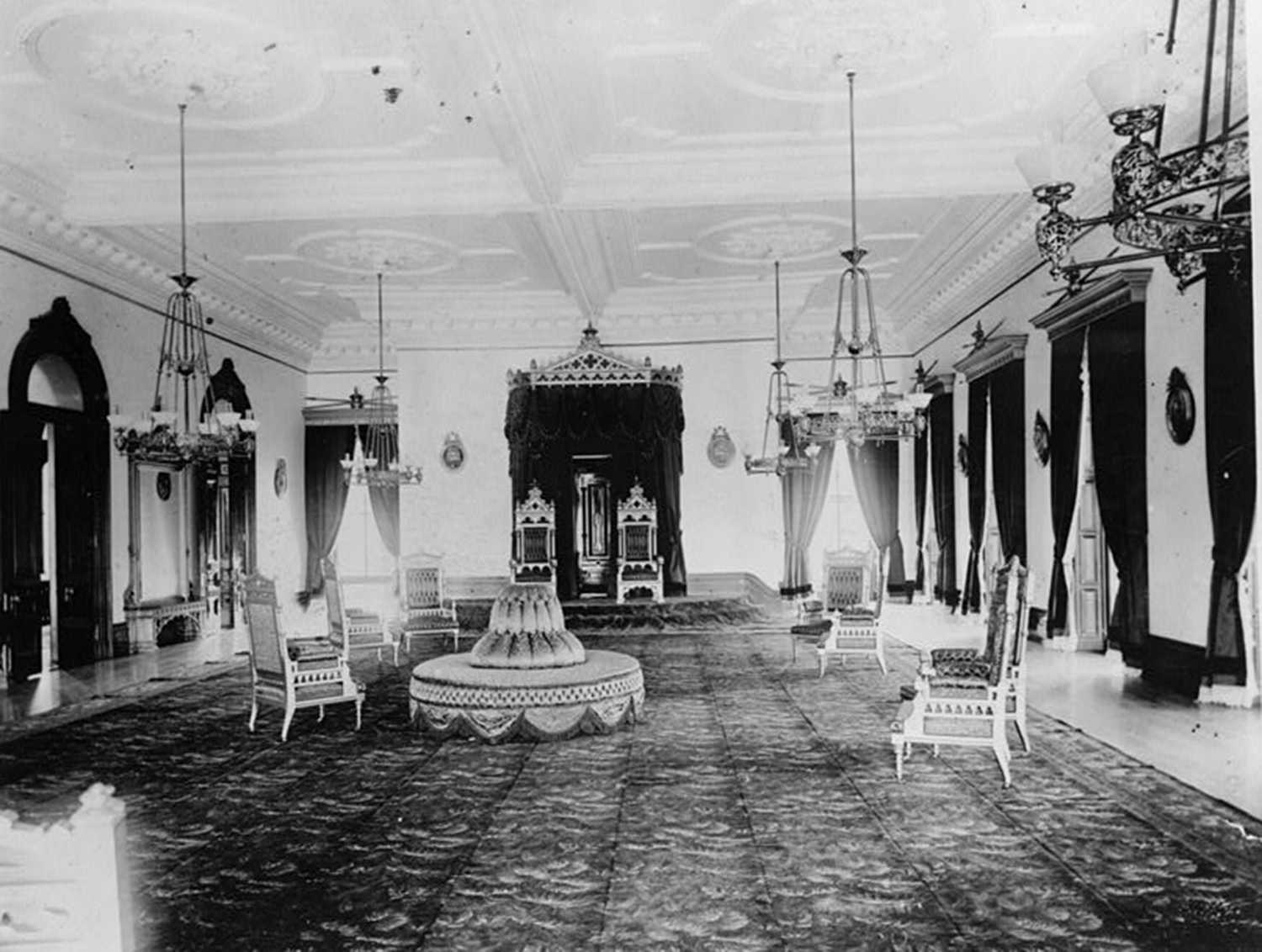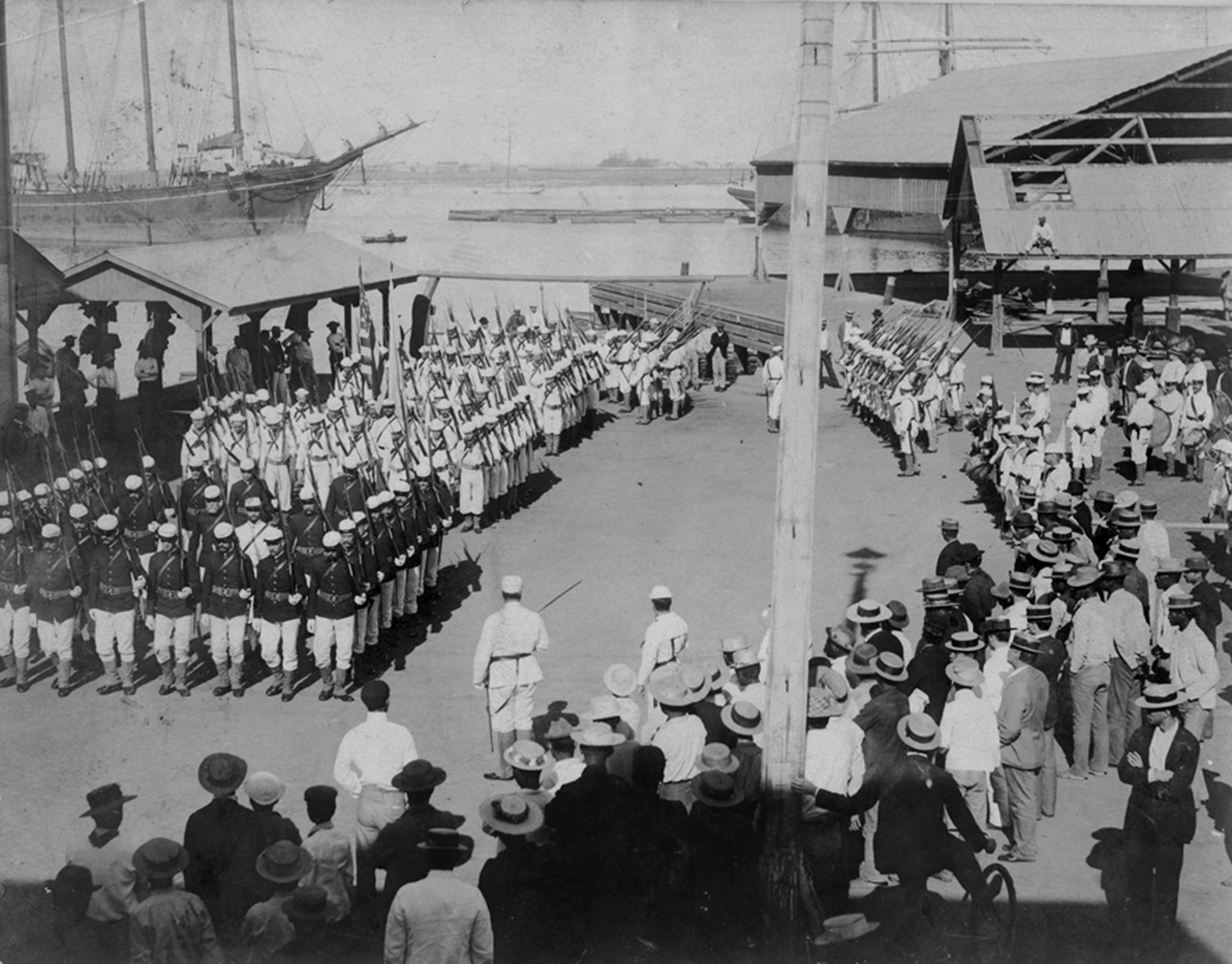
(Featured photo by Carol M. Highsmith, courtesy Library of Congress)
Why did Hawaii become part of the United States? How did Native Hawaiians respond?
Pacific Islanders ruled the Hawaiian Islands for nearly a thousand years until, in the 19th century, European and American colonizers began to settle the islands. Settlement changed the islands' dominant culture and European disease devastated the population of native Hawaiians. After a series of coups and Constitutional changes, the United States government annexed the islands and Hawaii became part of the growing American empire in 1898. But the Hawaiian Royal Family and the native Hawaiians did not turn over their Kingdom quietly: They protested. King Kalakaua and then his sister, Queen Liliuokalani, failed to withstand the push for American "Manifest Destiny," but their protest became an inspiration for civic activism and their Palace -- a lavish mix of indigenous and European architecture -- became a powerful symbol of Hawaiian heritage and history.
Where it fits into the curriculum
The lesson could be used in middle and high school units relating to Hawaiian history, 19th Century American Expansionism, Globalization, Cultural Exchanges, Colonization, and Architecture.
Time Period: Late 19th Century and early 20th Century
Objectives
2. To identify the ways European and American influence affected the Hawaiian Islands in the late nineteenth century;
3. To describe the Hawaiian and American arguments for and against annexation;
4. To identify a historical site of protest and explain why citizens choose to exercise their 1st Amendment rights at that location.
National History and Social Studies Standards
This lesson relates to the UCLA National Center for History in the Schools National History Standards:
- US History Era 6, Standard 4B: The student understands the roots and development of American expansionism and the causes and outcomes of the Spanish-American War.
- US History Era 7, Standard 2A: The student understands how the American role in the world changed in the early 20th century.
- Theme I: Culture;
- Theme II: Time, Continuity, and Change;
- Theme III: People, Places, and Environments;
- Theme IV: Individual Development and Identity;
- Theme IX: Global Connections;
- Theme X: Civic Ideals and Practices.
See the Full Lesson (PDF) for details about how the these Standards and Themes relate to the lesson. Search our Lesson Plans by National History Standards or Lesson Plans by Social Studies Standards to identify lessons that correspond with the eras and themes you want to teach.
Materials Found in the Full Lesson
- Setting the Stage: This short-essay with background information is intended for the teacher's reference, to use in a lecture or answer questions students might have during the lesson.
- Getting Started: This image and short question is intended to jump-start students' "inner historian."
Image: Historic Photo of Iolani Palace (JPG,TIF)
- Locating the Site: Maps orient the students and encourage them to think about how place affects culture and society. Accompanying Question Set available in the Full Lesson (PDF).
Map 1: Territorial Acquisitions of the United States (JPG,TIF)
Map 2: Honolulu, Oahu, 1901 (JPG,TIF)
- Determining the Facts: Primary and secondary source readings for students. Accompanying Question Sets available in the Full Lesson PDF.
Reading 1: Hawaiian History.
Reading 2: A Song by King Kalakaua, circa 1881.
Reading 3: The Iolani Palace.
Reading 4: Letter from Queen Liliuokalani of Hawaii to President William McKinley of the United States, June 17, 1897.
- Visual Evidence: Photos and other documents for students to examine. Select JPG for standard size or TIF to download a larger file. Download the Full Lesson (PDF) to access the Question Sets for each image.
| Photo 1: The first Iolani Palace, built in 1844. |
Photo 2: Historic image of Iolani Palace, completed in 1882. |
 |
 |
| Photo 3: Iolani Palace Throne Room, 1880s. |
Photo 4: US Marines Landing in Honolulu during the Overthrow of Liliuokalani, 1893. |
 |
 |
| Illustration 1: Patient waiters are no losers, by Louis Dalrymple. Published in New York City, January 13, 1897. | |
 |
|
"Putting it all Together" Activities
- Activity 1: Extra! Extra! Exploring 19th Century Annexation Op-Eds
- Activity 2: Discover Civic Activism at Iolani Palace and in Your Community
- Activity 3: Whose Destiny? Study the effects of American expansion on indigenous cultures
The National Register of Historic Places lists Iolani Palace. Useful information can also be found in the NRHP documentation for the Hawaii Capital Historic District. These records describe the physical palace site and its surroundings as well as their historical significance.
The Palace is featured in the NPS travel itinerary, Asian American and Pacific Islander Heritage. This resource includes an essay about Asian American and Pacific Islander history.
Iolani Palace
The Friends of Iolani Palace manage the historic site today and its official website. The website is a good source of information about the Palace history and the history of the Hawaiian Royal Family. The site also provides details about planning for a guided tour.
The library of the Iolani School, a preparatory school in Honolulu, has compiled a collection of online resources related to Hawaiian History. These include targeted collections from the Library of Congress, the Hawaii State Archives, the University of Hawaii at Manoa Library and other sources.
Library of Congress
The Library of Congress maintains state-specific exhibits of primary sources for the benefit of teachers and students. The Hawaii collection highlights interesting photographs, documents, and other media related to Hawaiian history.
The Park Service's Historic American Buildings Survey documented Iolani Palace in 1984. The Library of Congress hosts this documentation on its website, along with architectural drawings and historic photographs.
The University of Hawaii at Manoa Library Digital Archive
The library at University of Hawaii –Manoa maintains extensive digital collections of historic documents and photographs. The Hawaiian Annexation documents collection includes the text of the Anti-Annexation petitions, Congressional reports and debates, as well as many letters between Hawaiian and American political leaders.
Hawaii State Archives Digital Collections
The Hawaii state archives maintains a number of digital historic records, include an extensive historic photograph collection.
About this lesson
This lesson is based on the National Register of Historic Places file, “Iolani Palace” (with photos). This lesson was published in 2016. The lesson was written by Ben Hurwitz, graduate student and National Council for Preservation Education intern working in the Office of Outreach, Education and Training. It was edited by Teaching with Historic Places staff at NPS Cultural Resources Office of Interpretation & Education. This lesson is one in a series that brings the important stories of historic places into classrooms across the country.
Last updated: June 26, 2018
